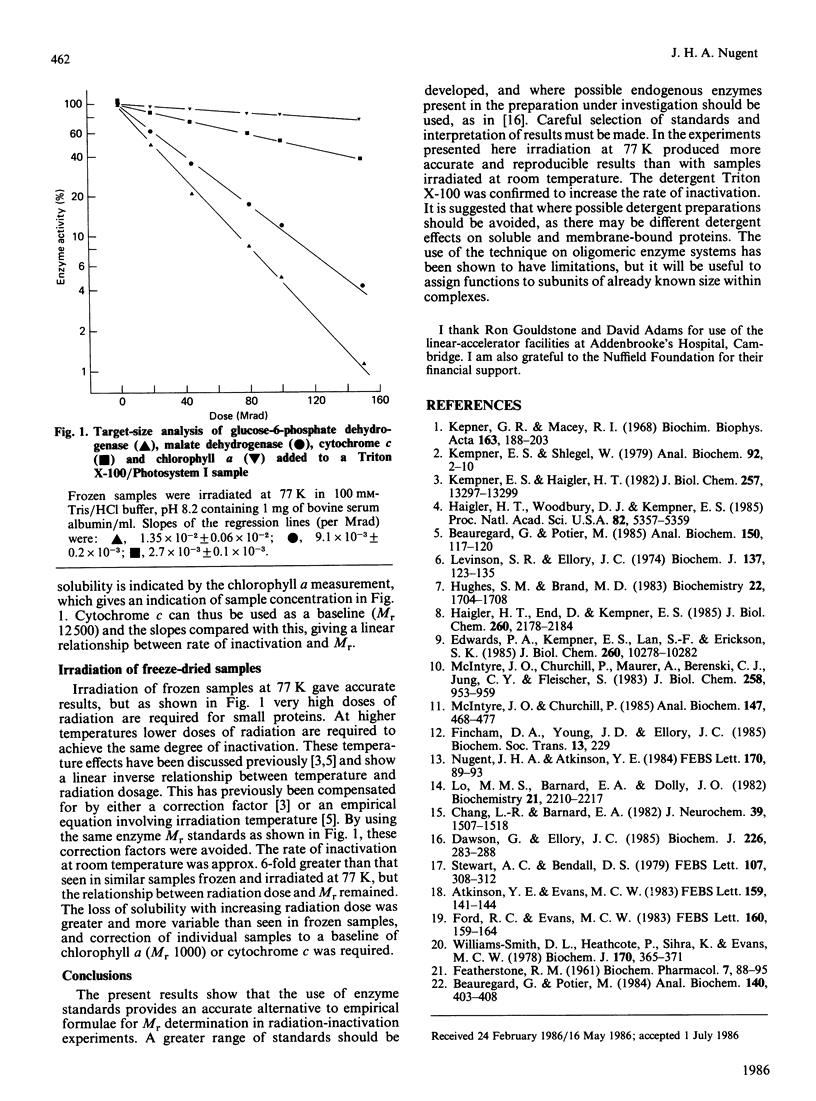Abstract
The accuracy of the radiation-inactivation technique for estimating molecular size was investigated with a range of proteins of known molecular mass. With the use of irradiation with a 16 MeV electron beam, inactivation was examined both in frozen samples at 77 K and in freeze-dried samples at room temperature. The effect of the presence of detergents and chloroplast membrane preparations was also measured. It was demonstrated that proteins added as internal standards, including malate dehydrogenase, glucose-6-phosphate dehydrogenase and cytochrome c, can provide an accurate calibration of molecular size. However, a disadvantage of the technique was that the target size of oligomeric enzymes could be that of either the monomers, dimers or higher oligomers. The detergent Triton X-100 increased the rate of inactivation of the proteins investigated.
Full text
PDF



Selected References
These references are in PubMed. This may not be the complete list of references from this article.
- Beauregard G., Potier M. Radiation inactivation of membrane proteins: molecular weight estimates in situ and after Triton X-100 solubilization. Anal Biochem. 1984 Aug 1;140(2):403–408. doi: 10.1016/0003-2697(84)90185-4. [DOI] [PubMed] [Google Scholar]
- Beauregard G., Potier M. Temperature dependence of the radiation inactivation of proteins. Anal Biochem. 1985 Oct;150(1):117–120. doi: 10.1016/0003-2697(85)90448-8. [DOI] [PubMed] [Google Scholar]
- Chang L. R., Barnard E. A. The benzodiazepine/GABA receptor complex: molecular size in brain synaptic membranes and in solution. J Neurochem. 1982 Dec;39(6):1507–1518. doi: 10.1111/j.1471-4159.1982.tb07983.x. [DOI] [PubMed] [Google Scholar]
- Dawson G., Ellory J. C. Functional lysosomal hydrolase size as determined by radiation inactivation analysis. Biochem J. 1985 Feb 15;226(1):283–288. doi: 10.1042/bj2260283. [DOI] [PMC free article] [PubMed] [Google Scholar]
- ELLMAN G. L., COURTNEY K. D., ANDRES V., Jr, FEATHER-STONE R. M. A new and rapid colorimetric determination of acetylcholinesterase activity. Biochem Pharmacol. 1961 Jul;7:88–95. doi: 10.1016/0006-2952(61)90145-9. [DOI] [PubMed] [Google Scholar]
- Edwards P. A., Kempner E. S., Lan S. F., Erickson S. K. Functional size of rat hepatic 3-hydroxy-3-methylglutaryl coenzyme A reductase as determined by radiation inactivation. J Biol Chem. 1985 Aug 25;260(18):10278–10282. [PubMed] [Google Scholar]
- Haigler H. T., End D., Kempner E. Molecular size of the epidermal growth factor receptor-kinase as determined by radiation inactivation. J Biol Chem. 1985 Feb 25;260(4):2178–2184. [PubMed] [Google Scholar]
- Haigler H. T., Woodbury D. J., Kempner E. S. Radiation inactivation of ricin occurs with transfer of destructive energy across a disulfide bridge. Proc Natl Acad Sci U S A. 1985 Aug;82(16):5357–5359. doi: 10.1073/pnas.82.16.5357. [DOI] [PMC free article] [PubMed] [Google Scholar]
- Hughes S. M., Brand M. D. Size changes of phosphodiesterase in bovine rod outer segments on illumination. Biochemistry. 1983 Mar 29;22(7):1704–1708. doi: 10.1021/bi00276a028. [DOI] [PubMed] [Google Scholar]
- Kempner E. S., Haigler H. T. The influence of low temperature on the radiation sensitivity of enzymes. J Biol Chem. 1982 Nov 25;257(22):13297–13299. [PubMed] [Google Scholar]
- Kempner E. S., Schlegel W. Size determination of enzymes by radiation inactivation. Anal Biochem. 1979 Jan 1;92(1):2–10. doi: 10.1016/0003-2697(79)90617-1. [DOI] [PubMed] [Google Scholar]
- Kepner G. R., Macey R. I. Membrane enzyme systems. Molecular size determinations by radiation inactivation. Biochim Biophys Acta. 1968 Sep 17;163(2):188–203. doi: 10.1016/0005-2736(68)90097-7. [DOI] [PubMed] [Google Scholar]
- Levinson S. R., Ellory J. C. The molecular form of acetylcholinesterase as determined by irradiation inactivation. Biochem J. 1974 Jan;137(1):123–125. doi: 10.1042/bj1370123. [DOI] [PMC free article] [PubMed] [Google Scholar]
- Lo M. M., Barnard E. A., Dolly J. O. Size of acetylcholine receptors in the membrane. An improved version of the radiation inactivation method. Biochemistry. 1982 Apr 27;21(9):2210–2217. doi: 10.1021/bi00538a033. [DOI] [PubMed] [Google Scholar]
- McIntyre J. O., Churchill P. Glucose-6-phosphate dehydrogenase from Leuconostoc mesenteroides is a reliable internal standard for radiation-inactivation studies of membranes in the frozen state. Anal Biochem. 1985 Jun;147(2):468–477. doi: 10.1016/0003-2697(85)90300-8. [DOI] [PubMed] [Google Scholar]
- McIntyre J. O., Churchill P., Maurer A., Berenski C. J., Jung C. Y., Fleischer S. Target size of D-beta-hydroxybutyrate dehydrogenase. Functional and structural molecular weight based on radiation inactivation. J Biol Chem. 1983 Jan 25;258(2):953–959. [PubMed] [Google Scholar]
- Stewart A. C., Bendall D. S. Preparation of an active, oxygen-evolving photosystem 2 particle from a blue-green alga. FEBS Lett. 1979 Nov 15;107(2):308–312. doi: 10.1016/0014-5793(79)80396-8. [DOI] [PubMed] [Google Scholar]
- Williams-Smith D. L., Heathcote P., Sihra C. K., Evans M. C. Quantitative electron-paramagnetic-resonance measurements of the electron-transfer components of the photosystem-I reaction centre. Biochem J. 1978 Feb 15;170(2):365–371. doi: 10.1042/bj1700365. [DOI] [PMC free article] [PubMed] [Google Scholar]


